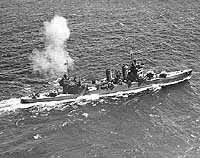
USS Astoria, a 9950-ton New Orleans class heavy cruiser built at the Puget Sound Navy Yard, was commissioned in April 1934. She spent the summer of 1934 on a shakedown cruise that took her across the Pacific to Australia, then joined the Scouting Force for operations with the U.S. Fleet. For the most of the rest of the decade Astoria took part in the fleet's regular program of exercises in the eastern Pacific region and the Caribbean.
Following the conclusion of Fleet Problem XX in early 1939, Astoria was assigned to carry the remains of the late Japanese Ambassador Saito back to his homeland. Upon this diplomatic mission's conclusion in late April, the cruiser visited China, the Philippines and Guam before returning to her normal duties with the U.S. Fleet. As tensions with Japan became increasingly severe in the autumn of 1941, Astoria escorted a troop transport to Manila. When the Japanese attacked Pearl Harbor on 7 December 1941, she was at sea with a task force taking aircraft to Midway. Later in the month, she participated in the abortive Wake Island relief expedition.
During the first half of 1942, Astoria operated with, or in support of, aircraft carrier task forces, primarily that built around USS Yorktown (CV-5). From February until May, she was in the south Pacific, protecting that vital region against the ongoing Japanese offensive. She screened the U.S. carriers during the Battle of the Coral Sea in early May, then steamed back to Pearl Harbor in time to take part in the Battle of Midway a month later. After Yorktown was disabled by Japanese air attack on 4 June, Astoria served as Rear Admiral Frank Jack Fletcher's flagship.
With the victorious outcome of the Midway battle, U.S. forces were able to begin offensive operations. New Japanese air bases in the southern Solomon Islands were the first objective. After several weeks of repairs and training near Pearl Harbor, Astoria went back to the south Pacific to join the invasion forces. During the 7-8 August 1942 landings on Guadalcanal and Tulagi, she provided gunfire support for Marines ashore and screened the amphibious task force against counter-attacks by Japanese aircraft. On the night of 8-9 August, Astoria was one of three heavy cruisers guarding the northern approach to the invasion area, and was the only one afloat after a blistering night action against a Japanese cruiser force. However, she was gravely damaged in this Battle of Savo Island. Though her crew struggled all through the morning of 9 August to save their ship, USS Astoria succumbed to her wounds shortly after noon, sinking into the depths of a body of water that would soon be called "Iron Bottom Sound", in recognition of all the ships that were lost there.
This page features selected views concerning USS Astoria (CA-34).
| If you want higher resolution reproductions than the digital images presented here, see: "How to Obtain Photographic Reproductions." |
Click on the small photograph to prompt a larger view of the same image.
|
Photo #: NH 91726 USS Astoria (CA-34) Entering Honolulu harbor during her shakedown cruise, 9 July 1934. Photographed by Tai Sing Loo. Donated by the U.S. Army Military History Institute, Carlisle Barracks, Pa. U.S. Naval History and Heritage Command Photograph. Online Image: 108KB; 740 x 595 pixels |
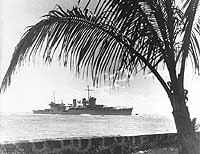 |
|
Photo #: NH 57404 USS Astoria (CA-34) Anchored off Long Beach, California, during the 1930s. U.S. Naval History and Heritage Command Photograph. Online Image: 107KB; 740 x 585 pixels |
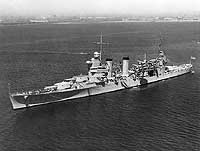 |
|
Photo #: 19-N-25346 USS Astoria (CA-34) Off the Mare Island Navy Yard, California, 11 July 1941. Photograph from the Bureau of Ships Collection in the U.S. National Archives. Online Image: 54KB; 740 x 610 pixels Reproductions of this image may also be available through the National Archives photographic reproduction system. |
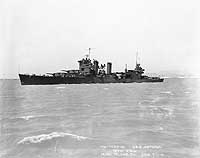 |
|
Photo #: 19-N-25347 USS Astoria (CA-34) Off the Mare Island Navy Yard, California, 11 July 1941. Photograph from the Bureau of Ships Collection in the U.S. National Archives. Online Image: 61KB; 740 x 615 pixels Reproductions of this image may also be available through the National Archives photographic reproduction system. |
 |
|
Photo #: NH 97682 USS Astoria (CA-34) Operating in Hawaiian waters during battle practice, 8 July 1942. She appears to be recovering floatplanes from off her starboard side. Note booms rigged below the forward superstructure to tow aircraft recovery mats, and starboard crane swung out. Official U.S. Navy Photograph, from the collections of the Naval Historical Center. Online Image: 161KB; 740 x 615 pixels |
 |
|
Photo #: NH 97683 USS Astoria (CA-34) Firing her after eight-inch guns, during battle practice in Hawaiian waters, circa 8 July 1942. Official U.S. Navy Photograph, from the collections of the Naval History and Heritage Command. Online Image: 185KB; 740 x 610 pixels |
 |
|
Photo #: 80-G-K-452 (Color) USS Astoria (CA-34) (center), and USS Minneapolis (CA-36) (left) Moored near Aiea Landing, Pearl Harbor, in late June 1942. Official U.S. Navy Photograph, now in the collections of the National Archives. Online Image: 62KB; 740 x 600 pixels Reproductions of this image may also be available through the National Archives photographic reproduction system. |
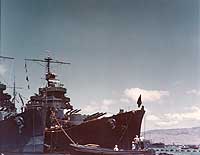 |
|
Photo #: 80-G-312004 Battle of Midway, June 1942 A Bombing Squadron Three (VB-3) SBD-3 scout bomber, probably flown by Lieutenant (Junior Grade) Paul A. Holmberg, ditches near USS Astoria (CA-34) at about 1342 hrs on 4 June 1942. This was one of two VB-3 planes that ditched near Astoria after they were unable to land on the damaged USS Yorktown (CV-5). A PBY is flying nearby, in right center. Official U.S. Navy Photograph, now in the collections of the National Archives. Online Image: 96KB; 740 x 620 pixels Reproductions of this image may also be available through the National Archives photographic reproduction system. |
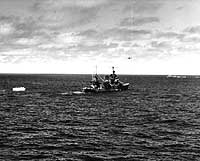 |
|
Photo #: 80-G-13477 Guadalcanal-Tulagi Invasion, August 1942 USS Astoria (CA-34) Joins Task Force 16 as it approaches Tulagi, about 6 August 1942. Official U.S. Navy Photograph, now in the collections of the National Archives. Online Image: 66KB; 740 x 605 pixels Reproductions of this image may also be available through the National Archives photographic reproduction system. |
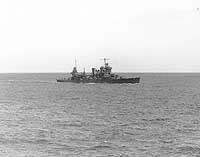 |
|
Photo #: 80-G-21946 USS Astoria (CA-34) Crew of 5"/25 gun # 3 (2nd gun from forward, starboard side) in action during gunnery practice, circa spring 1942. Note anti-flash head-dress and communications gear worn by the man operating the fuze setter; bearing markings on the gun's splinter shield; and old-style battle helmets. Official U.S. Navy Photograph, now in the collections of the National Archives. Online Image: 78KB; 740 x 610 pixels Reproductions of this image may also be available through the National Archives photographic reproduction system. |
 |
|
Photo #: NH 96383 USS Astoria (CA-34) Closeup view of the ship's bridge area, taken near the end of an overhaul at the Mare Island Navy Yard, California, 9 July 1941. Details seen include: main and secondary battery gun directors atop the battle lookout platform; newly-installed sky lookout position and 1.1" quadruple machine gun mounting; and siren on funnel front. Also note demarkation of dark and light grey paint of the ship's Measure 1 camouflage. U.S. Naval History and Heritage Command Photograph. Online Image: 125KB; 590 x 765 pixels |
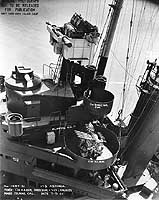 |
NOTES:
| If you want higher resolution reproductions than the digital images presented here, see: "How to Obtain Photographic Reproductions." |
Page made 14 October 2001
Coding updated 5 May 2009